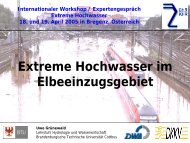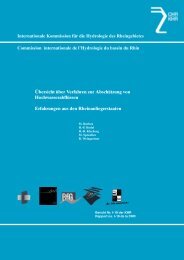ABSTRACTS 'Extreme Discharges' - CHR-KHR
ABSTRACTS 'Extreme Discharges' - CHR-KHR
ABSTRACTS 'Extreme Discharges' - CHR-KHR
Create successful ePaper yourself
Turn your PDF publications into a flip-book with our unique Google optimized e-Paper software.
esults obtained with this new methodology are described in Aalders et al. (2004) and Leander et al.<br />
(2005). The weather generator reproduces the distribution of the extreme 10-day rainfall quite well.<br />
Also the distributions of the maximum 1 day and 10 days discharges simulated with the generated<br />
meteorological data resemble those from the HBV simulations with observed meteorological data.<br />
Possible improvements of the methodology include the coupling with a hydraulic model for flood<br />
routing. The methodologies described above do not account for the possible impact of climate<br />
change. Several authors (e.g. Gellens & Roulin, 1998; Booij, 2005) have addressed the impact of<br />
climate change on the occurrence of floods in the Meuse basin. The general picture that evolves<br />
from these studies is that human-induced climate change will increase the risk of flooding in<br />
Northwest Europe. At present KNMI and RIZA are analysing the possibilities to apply the rainfall<br />
generator for the Meuse to the output of Regional Climate Model (RCM) simulations from the EU<br />
funded project PRUDENCE.<br />
Policy<br />
Over the last decade many measures have been taken or are being prepared to reduce the flood hazard<br />
and vulnerability to flooding in the Meuse basin (WHM/GTIM, 2002). The discharge levels<br />
that have been used to design those measures differ in the different regions of the Meuse basin. Like<br />
for most rivers, the flood protection level and the corresponding design discharge generally increase<br />
in downstream direction, where the effects of floods are potentially most devastating. This difference<br />
in design discharges complicates a supra regional tuning of measures.<br />
Conclusion<br />
The analysis of observed flood events as well as the first results of the rainfall generator for the<br />
Meuse reveal that there is no reason to assume that the observed floods in the Meuse are the most<br />
extremes that can occur. This motivates the need for a supra regional analysis of extreme conditions<br />
for the Meuse basin. The recently published and ongoing activities presented in this paper can support<br />
such an analysis.<br />
References<br />
Aalders, P., Warmerdam, P.M.M. & Torfs, P.J.J.F. (2004). Rainfall generator for the Meuse basin.<br />
3,000 year discharge simulations in the Meuse basin. Wageningen University, sub-department<br />
Water Resources. Report nr. 124. Wageningen, The Netherlands.<br />
Booij, M.J. (2005). Impact of climate change on river flooding assessed with different spatial model<br />
resolutions. Journal of Hydrology 303, 176-198<br />
Gellens, D. & Roulin, E. (1998). Streamflow response of Belgian catchments to IPCC climate<br />
change scenarios. Journal of Hydrology 210, 242-258.<br />
Leander, R. & Buishand, T.A. (2004). Rainfall generator for the Meuse basin. Development of a<br />
multi-site extension for the entire drainage area. KNMI-publication; 196-III, KNMI, De Bilt.<br />
Leander, R., Buishand, A., Aalders, P. & de Wit, M. (2005). Estimation of extreme floods of the<br />
river Meuse using a stochastic weather generator and a rainfall-runoff model. Submitted to<br />
Hydrological Sciences Journal.<br />
Parmet, B.W.A.H., Langemheen, W. van den, Chbab, E.H., Kwadijk, J.C.J., Lorenz, N.N. and<br />
Klopstra, D. (2002). Analyse van de maatgevende afvoer van de Maas te Borgharen. Onderzoek<br />
in het kader van het randvoorwaardenboek 2001. RIZA rapport 2002.013. Arnhem, The<br />
Netherlands.<br />
7





